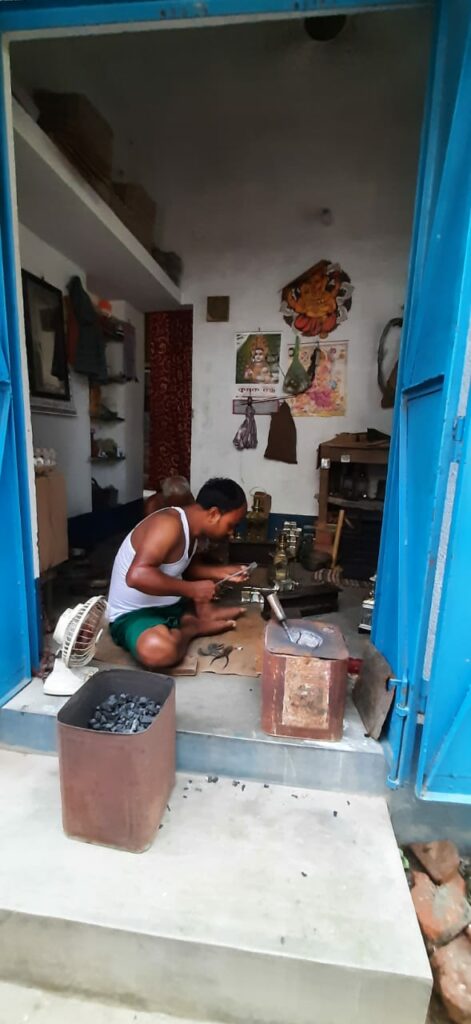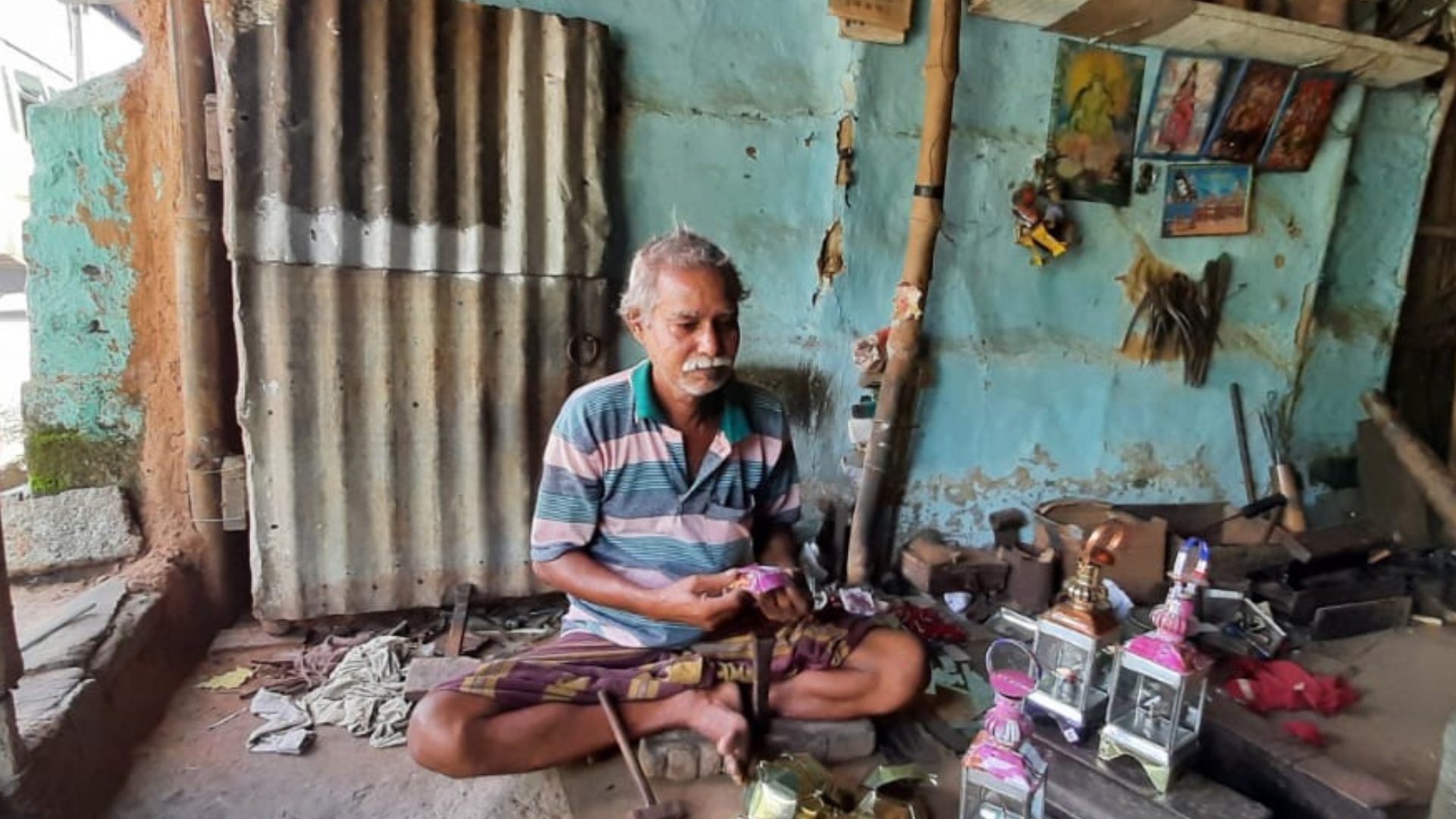Bishnupur, located in the Bankura district of West Bengal—is home to a variety of arts. During our survey of Bishnupur’s artisans in July this year, we ran into two such handicrafts which are vulnerable and are almost on the verge of dying out. Their current situation may be contrasting, but their fate appears to be similar.
The art of making lanterns
Lanterns were once a common household item, especially in rural areas, but with the spread of electricity, lanterns now mostly serve decorative purposes. The generational craft of making lanterns—the livelihood of many artisans—is now being obliterated. While looking for lantern artisans in the town, we were mostly greeted by shutters that remained closed throughout the day. The locals stated that this art is on its path to demise.

Pritam Debnath was found crouched over in his dilapidated workshop situated along the highway, hammering the tin used to make the lantern. The old man in his seventies has been engaged in this craft since he was 22 years old. Having learned it from his elder brother, the production process has remained the same over time. He works for almost ten hours a day which yields about 12-14 lanterns.
Bishnupur, located in the Bankura district of West Bengal—is home to a variety of arts. During our survey of Bishnupur’s artisans in July this year, we ran into two such handicrafts which are vulnerable and are almost on the verge of dying out. Their current situation may be contrasting, but their fate appears to be similar.
Debnath’s work bears semblance to what is known as the ‘putting out system’ in labour economics—local mahajans supply him the raw materials required to make lanterns, which he puts to use with his own tools in his own workshop, and collects the end product from him. The mahajans sells the lanterns in shops in and around Bishnupur—“I sell the lanterns to the mahajans at a wholesale price of Rs.500 for a dozen who probably sell it for about Rs.60 a piece in the market.”
The noticeable fall in demand for lanterns has led to a drastic decrease in his earnings—“Previously, I would earn Rs.150-200 a day, but now I earn the same amount after two to three days of back-breaking work. This is why shops everywhere are closing down.” Because of his age, he is unable to take up any other work and is “stuck with this craft.” His earnings from making lanterns are insufficient to meet household expenses, and his family is crucially dependent on their son for survival.
“What I sold for Rs.6000 was being sold at a price exceeding one lakh rupees in a showroom in Goa. But this does not bother me as long as I receive my labour’s worth.”
“My son knows the craft of lantern-making, but this work has no future—he works in a big store and is not planning on continuing this craft.”
Debnath has a state-issued artisan card and used to go to fairs in Bishnupur. However, he has discontinued going to them in recent years. He states, “I get called to fairs, but I cannot make lanterns well anymore because I have difficulty with my sight—nobody is going to buy from me in the mela.”
Debnath probably could not catch up with the changing times. His craft may be collateral damage in the process of ‘creative destruction’ of capitalism, as famous economist Joseph Schumpeter would have put it.
“While there were hundreds of lantern artisans in Bishnupur, there are only a handful of them currently. I want the craft to die with me. My shop is on the verge of being shut.”
Some kilometres away in Bishnupur itself, however, there is another family of lantern artisans who are somehow surviving these changing times.
“The craft of making lanterns is indeed in a vulnerable state. Most shops have shut down, and these artisans have moved on to other jobs. Other lantern artisans probably do not know how to make other types of lanterns. We do, which is why we are still surviving,” Saikat Manna states while working away at a lantern with his father in their workshop.
Sunil Manna and his family are engaged in the generational craft of making lanterns. However, theirs is not the putting out system as in the previous case; they get their own raw materials from Kolkata and from local markets and sell their products in and around Bishnupur, not only through shopkeepers who purchase lanterns at wholesale prices but also in retail to local customers.
While the production process has remained the same in both cases, the Manna family has been successful in keeping up with changing demand patterns. They have shifted their focus from making utility lanterns to decorative ones, which are demanded in temples and in homes and restaurants. They also sell in the popular Poramatir Haat in Bishnupur on Saturdays and at fairs organised by the government.
However, their concern for continuing the craft emanates not from the demand but from the supply side. Sunil Manna states,
“We go to Kolkata once a month to source our raw materials, but their prices have been increasing constantly. If this continues, then we will not be able to earn any profit, and will be forced to discontinue making lanterns altogether.”
Both hold the artisan card issued by the State government and get called to participate in government-organised fairs. However, when they tried to secure a loan a few years back to bolster their craft, they were turned down and discouraged from applying for loans again.
The craft of the cards
‘Doshabotar taash’ or playing cards depicting the ten avatars of Lord Vishnu, and popularly known as Ganjifa, is a craft unique to Bishnupur. The legend goes that Raja Bir Hambir was influenced by this game of cards played by women of the Mughal palace during their spare time and introduced it in Bishnupur. Ganjifa would be played among five players across several rounds with 120 cards—ten avatars of Lord Vishnu each depicted as king and minister, and ten cards each of the symbols of the ten avatars. The responsibility of making these cards in Bishnupur was given by the king to some craftsmen who were initially brought as soldiers from Rajasthan. They were granted land and were conferred the title of Fouzdar.
We were informed of this legend from the current generation of the Fouzdar family in Bishnupur, who have continued to practice this art for 42 years now. With no change in the production process, the cards are entirely handmade and hand-painted. Even the raw materials used are common household items while the glue and the colours for painting are all extracted from natural sources.
The family has never hired any workers for this craft; the women of the household contribute mainly by polishing the surface of the cards to facilitate painting and by extracting the natural colours. The more skilled jobs of drawing and painting the avatars on the cards are reserved for men whose working hours depend entirely on the orders received.

Since the game is no longer played nowadays, they have changed the products to serve decorative instead of leisurely purposes. Accordingly, they make sets of ten cards of each of the avatars and the symbols.
“There is still sufficient demand for this product; in fact, it has increased over time. People all over the world wish to collect this product for decorative purposes. You will not get this anywhere except me.”
Fouzdar holds an artisan card and has attended a number of fairs. He also sells his products to Biswa Bangla and various NGOs and showrooms in Kolkata. About the market price of the product in showrooms, he stated,
“What I sold for Rs.6000 was being sold at a price exceeding one lakh rupees in a showroom in Goa. But this does not bother me as long as I receive my labour’s worth.”
In spite of the pride he expressed in this craft, he is pessimistic about the future generation of Fouzdars continuing to make Doshabotar taash. He claims, “The young generation nowadays does not have the tenacity and the patience that this craft demands.”
We had the opportunity of talking to artisans of a craft which many—even in Bengal itself—are not aware of. Six thousand kilometres away from where Schumpeter propounded the theory of creative destruction of capitalism, the lantern artisans are experiencing this phenomenon.
Also read: Women Artists: The Necessity Of Unheard Voices In Art
While the craft of Debnath and others perishes in the face of changing times, the Manna family is still holding their ground. On the other end of town, the last man standing with the curious craft of doshabotar taash does have a lot on his plate right now. But he is not hopeful about the next generation taking the craft forward. They are expected to take up more secure and modern jobs at air-conditioned offices in urban areas of the country, leaving behind centuries-old art in the dark.
We are grateful to Mr. Amitabha Pal for helping us through the survey.
Also read: The Commodification Of Frida Kahlo: The Artist Beneath The Image On Cushions And Tote Bags
Satyaki Dasgupta is a PhD student at Colorado State University. Annesha Mukherjee is a PhD scholar at the Centre for Development Studies, Kerala.
Featured image source: Satyaki Dasgupta and Annesha Mukherjee





Thanks for writing the beautiful post and information to the public.
We must find a way how these cottage industries can be survived. Government also should take it seriously to explore the potential if these artisans.